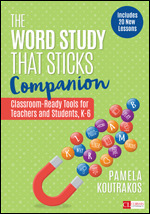The Word Study That Sticks Companion
Classroom-Ready Tools for Teachers and Students, Grades K-6
Corwin Literacy
First Pamela Koutrakos delivered a systematic approach to inquiry-based, student-centered, and joyful word study in her book Word Study That Sticks. Now, in The Word Study That Sticks Companion, Koutrakos offers tools and resources to help teachers put those structures, lessons, and routines into action.
Loaded with teacher-facing resources such as planning and assessment tools, and student-facing tools such as reproducible minicharts, choice checklists, and self-assessments, The Word Study That Sticks Companion includes
- Ready-to-go materials that greatly minimize the time teachers spend preparing, creating, and revamping word study lessons
- More than 100 student-friendly, reproducible minicharts for student notebooks that summarize the routines in each area of word study and support robust word learning
- Twenty brand-new word study lessons to extend the learning throughout the year and across content areas
Ideas for word study notebooks and choice charts that give students ownership of daily practice - Suggestions for replicating many routines and tools in a digital format
- Customizable cycle schedules, checklists, look-fors, planning guides, record-keeping forms, and other tools that help teachers crystalize priorities, organize instruction, and adapt for all learners
The routines and resources here can be used within any curriculum, as they transcend any one program, philosophy, or approach to word study. The Word Study That Sticks Companion enables consistent, authentic, and independent word study practice in K–6 classrooms.
With these materials in hand, students can take charge of their learning, and teachers gain more time for differentiated instruction. Discover what’s possible when you ditch word study worksheets and workbooks once and for all!
Free resources
Activities: "Picture It" and "Word Continuums"
Use these activities from The Word Study That Sticks Companion by Pamela Koutrakos with your young readers to expand their word learning.
If/Then Chart for Matching Students to Patterns and Words
Use this helpful chart from The Word Study That Sticks Companion by Pamela Koutrakos to match your students to the patterns and words they may be prepared to learn depending on their understanding.
Activities for Word Learning
Use these activities from The Word Study That Sticks Companion by Pamela Koutrakos with your young readers to expand their word learning.


